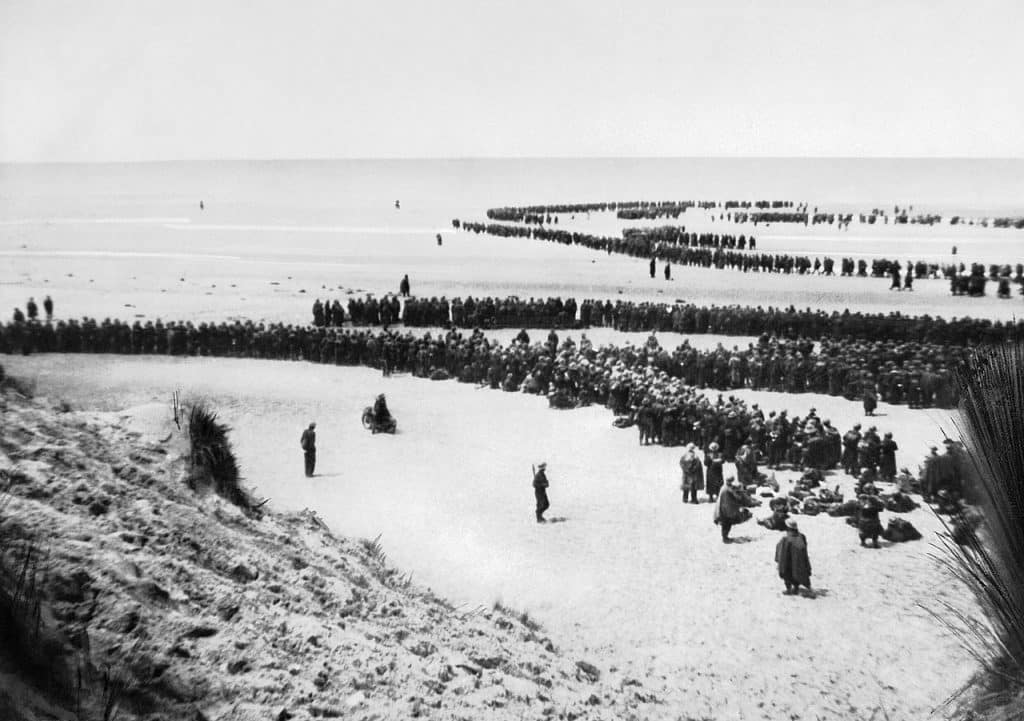Operation Dynamo was the code name given to the evacuation from Dunkirk, which involved the rescue of more than 338,000 British and French soldiers from the French port of Dunkirk between 26th May and 4th June 1940.
The evacuation, sometimes referred to as the “Miracle of Dunkirk”, was a big boost for British morale at such an early point in the war, however Prime Minister Winston Churchill recognised that the greatest challenge still lay ahead, as Nazi ambitions then turned toward Britain.
After Nazi Germany invaded Poland in September 1939, France and the British Empire declared war on Germany imposing an economic blockade and the British Expeditionary Force (BEF) was sent to help defend France. After what became termed as “the Phoney War” which lasted from October 1939 to April 1940, Germany invaded Belgium, the Netherlands, and France on 10th May, with three Panzer Corps’ attacking through the Ardennes and driving northwest to the English Channel.
This was yet another example of the Germans new approach to modern warfare known as Blitzkreig and by 21st May, large numbers of Belgian, British, and French troops were cut off and surrounded by German troops following the six-week Battle of France. The German forces had trapped the BEF, the remains of the Belgian forces, and three entire French field armies along the northern coast of France.
In a speech to the House of Commons, British Prime Minister Winston Churchill called this “a colossal military disaster”, saying “the whole root and core and brain of the British Army” had been stranded at Dunkirk and seemed about to perish or be captured.
The BEF commander, Viscount General Gort immediately saw evacuation across the Channel as the best course of action, and began planning a withdrawal to Dunkirk, the closest good port.
Late on 23rd May, a halt order was issued by Generaloberst Gerd von Rundstedt, commander of Army Group A. Adolf Hitler approved this order the next day, and had the German High Command send confirmation to the front. Destroying the trapped BEF, French, and Belgian armies was left to the Luftwaffe (the German Airforce) until the order was rescinded on 26th May.
This short window of respite however, gave Allied forces the time to construct defensive works and pull back large numbers of troops to fight the Battle of Dunkirk. From 28th to 31st May, in the Siege of Lille, the remaining 40,000 men of the French First Army fought a delaying action against seven German divisions, including three armoured divisions.
Having already retired from the Royal Navy before the war, Admiral Bertram Ramsay was recalled in 1939 and directed the evacuation. He and his staff worked in a room deep in the Dover cliffs that had once contained a dynamo, a type of electrical generator, giving the operation its name. You can actually still visit the site which is (normally) open to the general public and further details can be found by clicking here
‘Dynamo’ began on 26th May. Strong defences had been established around Dunkirk, and the Royal Air Force sent all available aircraft to protect the evacuation. The gently shelving beaches meant that large warships could only pick up soldiers from the town’s East Mole, a long pier-like sea wall, which extended into deep water, or send their boats on the beaches to collect them. To speed up the process, the British Admiralty appealed to the owners of small boats across Britain for help. These became known as the ‘little ships’ of Dunkirk. Some men were ferried to the larger ships by these little Ships, which were essentially a flotilla of hundreds of merchant marine boats, fishing boats, pleasure craft, yachts, and lifeboats called into service from Britain.
Many troops were able to embark from the harbour’s protective “mole” onto 39 British Royal Navy destroyers, 4 Royal Canadian Navy destroyers, at least 3 French Navy destroyers, and the variety of civilian and merchant ships. Many personnel had to wade out from the beaches, waiting for hours in shoulder-deep water.
All resistance in Dunkirk ended at 9.30am on 4th June 1940. The BEF lost 68,000 soldiers during the French campaign. Ninety thousand remained to be taken prisoner, most for the duration and the BEF left behind the bulk of its tanks, equipment and heavy guns.
Churchill and his advisers had expected that it would only be possible to rescue 20,000 to 30,000 men from Dunkirk and indeed on the first day only 7,669 Allied soldiers were evacuated. However, by the end of the eighth day, a staggering 338,226 had been rescued by the hastily assembled fleet of over 800 vessels.
The Dunkirk evacuation was an important event for the Allies. If the BEF had been captured in its totality, it would have meant the loss of Britain’s only trained troops and the collapse of the Allied cause. The successful evacuation was a great boost to civilian morale in Britain, and created the ‘Dunkirk spirit’ which helped it to fight on in the summer of 1940.
Following the evacuation and in his speech to the House of Commons in London on 4th June 1940, Churchill also reminded the country that “we must be very careful not to assign to this deliverance the attributes of a victory. Wars are not won by evacuations” although he nonetheless hailed their rescue as a “miracle of deliverance”.
Our thanks to the Imperial War Museum for confirmation of many of the facts and figures provided in this article. You can find out more here: https://www.iwm.org.uk/
